Since the news that the royal couple, the Duke and Duchess of Cambridge, were expecting their first child was announced in December 2012, shortly followed by the Duchess’ hospitalization early in her pregnancy with hyperemesis gravidarum and then the seemingly endless wait for the child to be born, there had been much anticipation and worldwide attention for the joyous event.
Finally on July 22, 2013, Royal Highness Prince George of Cambridge, the first child of Prince William and the former Kate Middleton, was born and he will be third in line of succession to the British throne. The royal baby will be the third great-grandchild of Queen Elizabeth II (her eldest grandson and Princess Anne’s son, Peter Philips has two daughters) and the first grandchild of Prince Charles. The last time a serving monarch had a great-grandchild born in a direct line of succession to the throne was over 120 years ago, in 1894 when Queen Victoria was sovereign and the future Edward VIII was born.
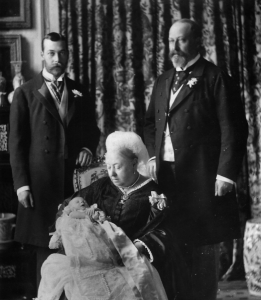
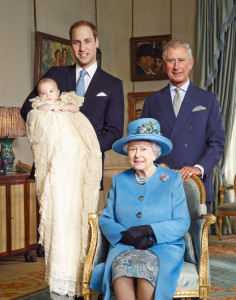
Interesting Facts and Traditions of the Birth of a Royal
- Royal Highness Prince George was born in the Lindo Wing of St. Mary’s Hospital in London, England. It is the same hospital where 31 years earlier, Prince William was born to Prince Charles and the late Princess Diana. This was not always the case of a heir to the British throne being born in a hospital, Prince Charles was born at Buckingham Palace and the Queen was born at the home belonging to her mother’s parents at 17 Burton Street in Mayfair, England.
- Prior to 1948, the Home Secretary was required to attend the birth of a royal baby to ensure that the child born was a legitimate heir to the throne. Since that time it was determined that there was no constitutional requirement needed for his presence. This number of birth witnesses is very small in comparison to the 42 witnesses that were present to verify the birth of the son of King James III in 1688 when the legitimacy of the pregnancy was called into question and the true heir to the British throne was in doubt.
- An official public proclamation with information on the baby’s gender, time of birth and weight and it is signed by the royal doctors and this framed announcement is traditionally placed near the gates of Buckingham Palace after the Queen and the immediate families of the Duke and Duchess of Cambridge have been informed of the birth of the royal baby. This old-fashioned custom is still observed even in the modern age of worldwide mass media coverage. For the birth of Prince George an announcement was also made on the royal website.
- Royal births are traditionally celebrated with gun salutes, 41 rounds fired in Green Park by the King’s Troop Royal Horse Artillery and 62 rounds fired at the Tower of London by the Honourable Artillery Company. The British flag will also be flown from all of England’s government buildings, Royal Navy ships and military installations.
- The names given to royal babies are not usually revealed to the public for several days. When Prince William was born in 1982, the name was not made public and announced until seven days later. When Prince Charles was born in 1948 it took even longer and it was a month before his name was revealed just prior to his christening. Normally royal babies often have several forenames; the Duke of Cambridge was christened Prince William Arthur Philip Louis. Royal babies with the title of Royal Highness (HRH) normally do not need surnames, but if one is used there are three possible choices: Mountbatten-Windsor, Wales or Cambridge.
After the royal birth, there is always the customary photo of the newborn baby with their royal parents on the steps just outside the hospital for the hundreds of worldwide press that is waiting. Shown below are the photos in 2013 of Prince George with his parents the Duke and Duchess of Cambridge and in 1982 of Prince William with his parents, the Prince and Princess of Wales.
Details of a Royal Christening
- Traditionally, royal christenings are generally private affairs usually held at Buckingham Palace in the Music Room. For Prince George, his christening will take place at the small chapel at St. Jame’s Palace on October 23, 2013. The royal baby will be a three months old and the Archbishop of Canterbury will perform the ceremony. Besides the royal baby and his parents, there will be a small group of family, close friends and the child’s godparents. After the ceremony the group will sit for formal portraits that will be released to the media. On the occasion of Prince William’s christening, it was the Queen Mother’s 82nd birthday. Shown below are the christening photos from 1982 of Prince William, from 1948 of Prince Charles and from 1926 of Princess Elizabeth.
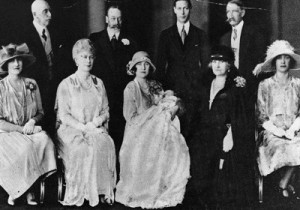
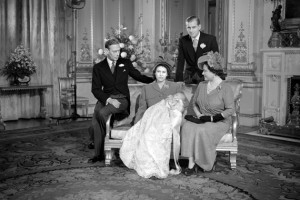
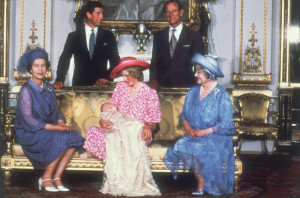
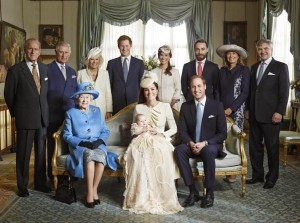
- In 1840, Queen Victoria commissioned a special silver baptismal font when she was expecting her first child with husband, Prince Albert. The font was made by Barnard & Co. and the symbol of the lily was used to represent purity and new life. The christening ceremony of Princess Victoria took place in February 1841 in the Throne Room at Buckingham Palace. According to a painting by C.R. Leslie, the font was placed on a circular table and the Archbishop of Canterbury used water from the River Jordon. For the new royal baby, the same silver font and water from the River Jordan will be used for his christening in the chapel at St. Jame’s Palace.
- For the birth of her first child, Queen Victoria also commissioned a lovely christening “robe” made with Honiton lace and lined in white satin, it has a very long skirt with an elaborate collar and bow. Since 1841 over 60 royal children have worn it for their christening including four Kings, King Edward VII, King George V, King Edward VIII and King George VI. Queen Elizabeth II wore it for her christening, as well as all her children and every grandchild except one. The last to wear it was Lady Louise Windsor, the daughter of the Earl and Countess of Wessex in 2004. The original robe was very old and fragile by that time and to preserve the historical outfit an exact handmade replica was made by the Queen’s dresser, Angela Kelly. Viscount Severn, the son of the Earl and Countess of Wessex, was the first to wear it at his christening in 2008.
- Royal babies usually have five or six godparents, although Prince William had eight. Possible godparents for William and Kate’s new son will more than likely include Prince Harry, Pippa and James Middleton. In addition royal experts expect at least two more godparents which would have to be someone from William and Kate intimate circle of friends.
- At the reception following the royal baby’s christening, it is traditional to serve the top tier of the parent’s wedding cake. This is a tradition that Prince William wanted to keep and after their wedding in 2011 the cake was specially preserved in the freezer awaiting the birth of their first child.
For more information the Music Room in Buckingham Palace where several royal christenings have taken place throughout the centuries, please check out yesterday’s Travel Post, “Buckingham Palace“.
Royal Update: On May 2, 2015 Princess Charlotte of Cambridge, the second child of Prince William and the former Kate Middleton, was born in the Lindo Wing of St. Mary’s Hospital in London, England which was the same hospital where her brother, Prince George, was born in 2013. Princess Charlotte’s christening will take place on July 5, 2015 in St. Mary Magdalene Church on the Sandringham Estate in Norfolk, England. For more information on Sandringham, please click on the link.

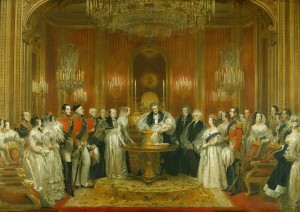
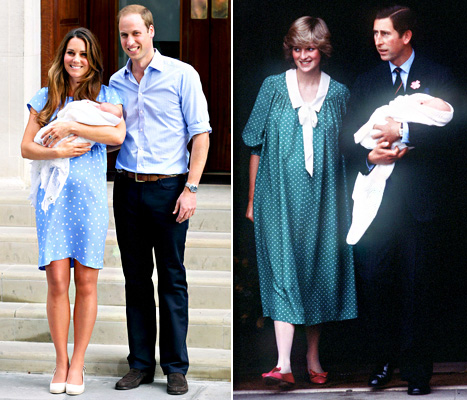
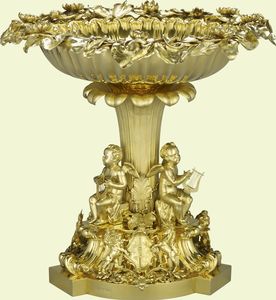
Pingback: Celebration – British Royal Weddings (Part 1) | The Enchanted Manor
Pingback: Crown Jewels of England (Part One) | The Enchanted Manor